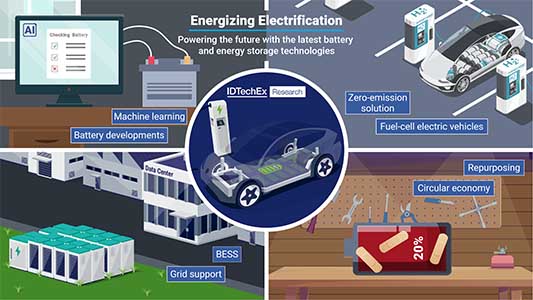The future of energy could be increasingly streamlined, sustainable, and efficient, with battery developments and the integration of machine learning. Li-ion batteries and hydrogen fuel cells are some of the most promising up-and-coming technologies responsible for allowing innovations within main industries, including automotives and energy storage. IDTechEx‘s portfolios of Batteries & Energy Storage and Electric Vehicles research reports cover the latest developments.
Sustainability meets electrification
Sustainability is one of the most renowned key words of the future, with one of its main accompaniments being the electrification of transport. In 2023, IDTechEx reported an 800GWh battery demand across different types of electric vehicles, showcasing the scope for battery technologies to have a future of success. IDTechEx’s report, “Electric Vehicles: Land, Sea, and Air 2025-2045” conveys that electric cars are the largest proportion driving this demand, having been responsible for 86% as of 2023.
Subsidies and restrictions are two governmental inputs that are likely to shape the electrification landscape going forward, as companies are pushing to meet net-zero targets and avoid potential charges on unnecessary emissions. These factors are expected to drive the future electrification onwards with increasing feasibility and incentivization.
Li-ion batteries are used in almost all electric vehicles on the road today, given their performance and cost characteristics, and are likely to continue to see uptake. In recent years, there has been a rapid increase in the market for Li-ion batteries, with annual demand growing from around 10GWh in 2010 to 1000GWh in 2024.

Source: IDTechEx.
Over US$400 billion is the amount predicted for Li-ion battery cells alone in 2035, and by 2030, an increase in the number of applications for Li-ion batteries is expected to be seen. The market is expanding past cars and encompasses different types of electric vehicles such as two and three wheelers, vans, and heavy-duty trucks. “Advanced Li-ion Batteries 2025-2035: Technologies, Players, Markets, Forecasts” is IDTechEx’s latest report on Li-ion batteries, exploring next-generation anode and cathode materials and a variety of applications.
Second-life batteries and AI machine learning
True sustainability is entering the battery sector with repurposing and recycling technologies. These up-and-coming technologies are beginning to reshape the landscape and could change the future of battery supply and demand, from material extraction, through to getting maximum use out of a battery’s potential.
Repurposing batteries from their first-life jobs may be able to provide a break from the reliance on the limited supply of critical materials including nickel, cobalt, and copper, and reduce the need for excessive material extraction. This will subsequently limit the carbon emissions produced as a result and bring down the high costs associated with these processes, creating more opportunity for sustainability in the future. The report, “Second-life Electric Vehicle Batteries 2025-2035: Markets, Forecasts, Players, and Technologies” offers greater insights into these processes.
Quicker cell testing methods, improved in-life diagnostics, and new material discoveries are all features which batteries will benefit from with the integration of AI into the development process. Improvements to battery safety will be significant, such as providing early warnings of thermal runaway in batteries with liquid electrolyte. Machine learning methods can also provide use at every stage of a battery’s lifecycle, from material selection, all the way to recycling and refurbishment at end-of-life, ensuring the best usage strategies for battery modules based on performance.

Source: IDTechEx.
As energy density demand is reaching all-time highs, the desire for new battery chemistries is increasingly prevalent. Close to reaching maximum energy density, Li-ion batteries may start to rapidly require changes to maintain their use within their main application sectors. IDTechEx’s report, “AI-Driven Battery Technology 2025-2035: Technology, Innovation and Opportunities” uncovers the technology used to enable AI’s research, discovery, and diagnostic capabilities within the battery sector, with several major applications.
Stationary energy storage and fuel cell technologies
The future will need to be one with fewer grid instability issues, if the penetration of variable renewable energy is to increase. Energy security could be improved with other sources of electricity generation, including energy storage technologies, nuclear fusion, stationary fuel cells, or wind and solar power. IDTechEx’s research report, “Batteries for Stationary Energy Storage 2025-2035: Markets, Forecasts, Players, and Technologies“, showcases the extensive capabilities of Li-ion batteries specifically to store energy at cost competitive prices, making BESS technologies more widely available.
Stationary hydrogen fuel cells are another means of energy storage with versatility amongst different applications. Using hydrogen and oxygen to create electricity, their sustainability and environmentally friendly nature is one of the main selling points for use within electric vehicles and commercial operations. When stacked together, these individual power generators are capable of powering high output systems effectively.

Source: IDTechEx.
Proton exchange membrane fuel cells (PEMFCs) are renowned for their quick power up times, compactness, and low temperature operation, making them an excellent choice for electric vehicles. They offer a certain convenience likely to be desired within the industry going forward, and promise high electrical efficiency and power density, making PEMFCs one of the ones to watch amongst fuel cell technologies going forward. The report “Fuel Cell Electric Vehicles 2025-2045: Markets, Technologies, Forecasts” encompasses IDTechEx’s research on trends, players, and the main applications predicted to be seen over the next twenty years.
Industrial power and commercial operations are likely to see a greater uptake of solid oxide fuel cells (SOFCs) due to their high-power output and fuel flexibility – a worthwhile investment into an enhanced future of power generation. Their efficiency and power benefits make them the most common technology in the industry, according to IDTechEx’s report, “Stationary Fuel Cell Markets 2025-2035: Technologies, Players & Forecasts“, as they pave the way for future developments and opportunities to improve efficiency further.
For more information on the latest battery technologies and energy storage developments, visit IDTechEx’s Electric Vehicles and Batteries & Energy Storage Research Reports and Subscriptions portfolios.












